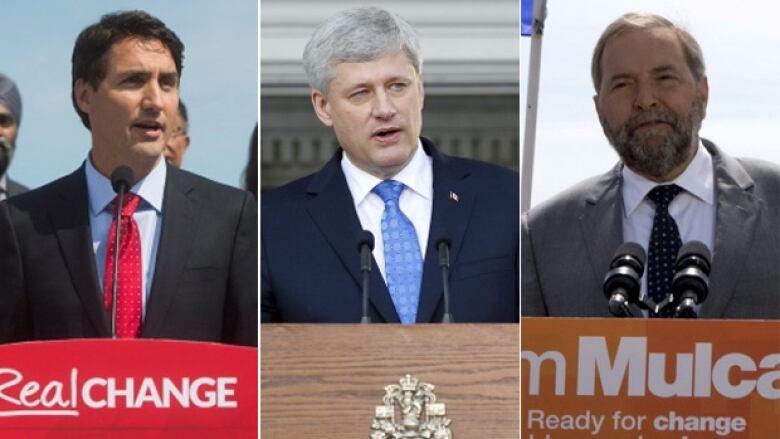Poll Tracker: Ontario behind tightening 3-way national race
The race gets tighter as polls show the Conservatives slipping and the Liberals improving slightly

This story posted earlier Friday has been updated to reflect EKOS poll numbers released after publication.
Movement away from the Conservatives in Ontariohas pushed the federal race back towards a close three-way contest. The latest numbers now put the gap between the first-place New Democrats and the third-place Liberals at just under fivepoints.
The CBC Poll Tracker gives the NDP an average of 31.9per cent support in the polls, with the Conservatives following closely at 30.1 per cent. The Liberals, in third, have the support of 27per cent of Canadians.
- Follow the polling trends in the Poll Tracker
- Latest federal seat projections
- Listen and subscribe to the Election Pollcast podcast
The Greens stand at 5.6per cent, while in Quebec the Bloc Qubcois has dropped to 17.7per cent and fourth place.
The bulk ofrecent polling has suggested that the Liberals have seen an improvement in their support levels since last week's leaders' debate. Four of the last fivenational polls have putthe Liberals between 27 and 29 per cent support. By comparison, the Liberals had registered under 27 per cent in nine of the previous 11 surveys.
With these levels of support, the New Democrats would likely win between 110and 136seats, while the Conservatives would take between 108and 143. The Liberals would capture between 73and 103seats. The overlap between the NDP and Tories has been a steady feature of the race for a couple months.
But the numbers have moved most significantly in Ontario.
At the end of July and into the first week of the campaign, the Conservatives had positioned themselves with a clear lead in Canada's largest province with as much as 36 per cent support. But recent polling now points to a close race, with the Tories holding a narrow edge at just over32per cent compared to 31 per cent for the NDP and 30 per cent for the Liberals. The Conservatives would still be likely to emerge with the most seats out of this equation, taking 45to 64seats in the province against 28to 44for the Liberals and 26to 36for the NDP.
Forum, Mainstreet and EKOSpolls
The three most recently published polls have pointed towards this tightening race, nationally as well as in Ontario. AForum Research poll published Thursday by theToronto Starhad the Liberals up by two points nationwide, while the leading New Democrats dropped five points from an abnormally high 39 per cent in Forum's first poll of the campaign.
Similarly, Friday's Mainstreet Research poll published by Postmedia showed the Conservatives dropping four points and the Liberals up two pointsamong decided and leaning voterssince a pre-election poll by the company. Of note is the shift in reporting by Mainstreet from decideds-only to a tally including leaning voters. Overall, the shifts among these decided and leaning voters narrowed the margin between the first- and third-place parties from nine points in a July 20-21 pollto just two.
Another poll published Friday, an EKOS Research poll for iPolitics, reduced the gap between the three parties by just under three points. But the EKOS survey stands out from the pack by posting Liberal support at just 24.2 per cent, up narrowly from EKOS's previous survey two weeks ago. While the trend is heading in the same direction as other surveys, it still hints at the potential for a poor showing for the Liberals and a race pitting just the Conservatives and New Democrats against each other.
CBC's Poll Trackeraggregates all publicly released polls, weighing them by sample size, dateand the polling firm's accuracy record. Upper and lower ranges are based on how polls have performed in other recent elections. The seat projection model makes individual projections for all ridings in the country, based on regional shifts in support since the 2011 election and taking into account other factors such as incumbency. The projections are subject to the margins of error of the opinion polls included in the model, as well as the unpredictable nature of politics at the riding level. The polls included in the model vary in size, dateand method, and have not been individually verified by the CBC.You can read the full methodology here.
The questions asked in the polls mentioned in this article were as follows:
Forum: "If a federal election were held today, which party are you most likely to vote for?"
Mainstreet: "If the federal election were today, which party would you support?
EKOS: "If the federal election were tomorrow, which party would you vote for?"












_(720p).jpg)


 OFFICIAL HD MUSIC VIDEO.jpg)
.jpg)



























































































